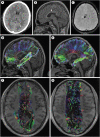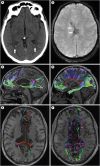Long-term Tractography Evaluation of Corpus Callosum Impairment After Severe Traumatic Brain Injury in Patients With Isolated Intraventricular Hemorrhage on Admission CT: Two Illustrative Cases and a Literature Review
- PMID: 37431372
- PMCID: PMC10329887
- DOI: 10.13004/kjnt.2023.19.e27
Long-term Tractography Evaluation of Corpus Callosum Impairment After Severe Traumatic Brain Injury in Patients With Isolated Intraventricular Hemorrhage on Admission CT: Two Illustrative Cases and a Literature Review
Abstract
Severe traumatic brain injury (TBI) is often associated with diffuse axonal injury. Diffuse axonal injury affecting the corpus callosum may present with intraventricular hemorrhage on baseline computed tomography (CT) scan. Posttraumatic corpus callosum damage is a chronic condition that can be diagnosed over the long term using various magnetic resonance imaging (MRI) sequences. Here, we present two cases of severe survivors of TBI with isolated intraventricular hemorrhage detected on an initial CT scan. After acute trauma management, long-term follow-up was performed. Diffusion tensor imaging and subsequent tractography revealed a significant decrease in the fractional anisotropy values and the number of corpus callosum fibers compared with those in healthy control patients. This study presents a possible correlation between traumatic intraventricular hemorrhage on admission CT and long-term corpus callosum impairment detected on MRI in patients with severe head injury by presenting demonstrative cases and conducting a literature review.
Keywords: Cerebral intraventricular hemorrhage; Corpus callosum; Diffuse axonal injury; Diffusion tensor imaging; Magnetic resonance imaging; Traumatic brain injury.
Copyright © 2023 Korean Neurotraumatology Society.
Conflict of interest statement
Conflict of Interest: The authors have no financial conflicts of interest.
Figures


References
-
- Atzema C, Mower WR, Hoffman JR, Holmes JF, Killian AJ, Wolfson AB, et al. Prevalence and prognosis of traumatic intraventricular hemorrhage in patients with blunt head trauma. J Trauma. 2006;60:1010–1017. - PubMed
-
- Bruns J, Jr, Hauser WA. The epidemiology of traumatic brain injury: a review. Epilepsia. 2003;44:2–10. - PubMed
-
- Chang MC, Jang SH. Corpus callosum injury in patients with diffuse axonal injury: a diffusion tensor imaging study. NeuroRehabilitation. 2010;26:339–345. - PubMed
Publication types
LinkOut - more resources
Full Text Sources

